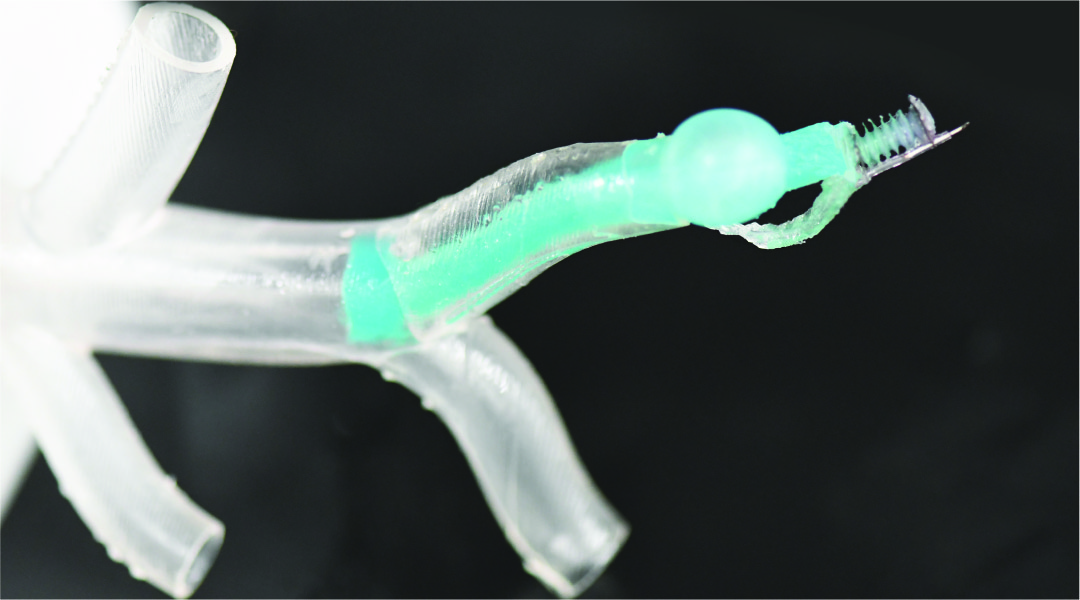In recent years, soft robotics has garnered a spotlight in the surgical field due to their scalability, flexibility, and the potential for safer interactions with biological tissues. These aspects of soft robotics are particularly beneficial in minimally invasive surgical procedures where surgeons must be able to perform many tasks within limited spaces.
Interventional bronchoscopy procedures stand to benefit greatly from the development of soft robots because of the challenging paths that a bronchoscope must traverse. Coupled with the small diameters of the lung branches, this makes it very difficult with traditional tools to reach deeper in the lungs, where early tumors are generally found.
However, when a robot is made smaller to fit in tighter spaces, it produces smaller forces before failing. This is especially relevant when the robot is made of soft materials.
A miniature soft robot
In lung biopsy procedures, a biopsy needle must be able to transmit a puncturing force into the desired tissue. This is often made difficult by the fact that surgeons manually impose this force far away from the needle meaning the force must travel the whole length of a bronchoscope.
Sheila Russo, assistant professor in mechanical engineering at Boston University, and her lab have developed a soft robot that avoids compromising its force transmission for size. The robot has a cylindrical continuum shape with a 3.5 mm diameter so that it can easily move through the lungs and has a needle deployment mechanism mounted on its tip. Its design seeks to maximize the benefits of soft robots by embedding multiple degrees of freedom into a miniature form factor.
The robot, published in Advanced Intelligent Systems, comprises three independent, fluid pressure-driven actuators. Each one is designed so that upon increasing the internal pressure, the robot behavior is controlled. These actuators can steer the robot into the branches of the lungs, stabilize the robot tip once it is close to a target, and deploy a needle to take a biopsy of the targeted tumor. This new robot allows for greater control over the biopsy needle than is traditionally given to a surgeon.
“An advantage of using soft materials,” said Russo, “is that we can exploit the fact that the robot can safely interact with biological tissue to anchor the robot within the lung branches.”
Ensuring safe operation
Stabilization of the robot is accomplished by a radially-expansive soft actuator embedded near its tip. Upon pressurization the actuator contacts the walls of the lung branch providing an anchor point from which the needle can be deployed. Deployment of the needle is then achieved with a linear soft actuator on the tip of the robot.
The robot is manufactured using a combination of silicone molding and microfabrication layering processes. Soft polymeric materials are used in these processes making the robot inherently flexible and highly scalable.
The researchers characterized each of the three mechanisms to demonstrate that the robot could both achieve high levels of flexibility and produce adequate forces to take a biopsy.
They validated this finding by placing the robot within a mock lung model and mimicking the intended surgical use. The robot was successful in using all of its actuation mechanisms to complete a simulated biopsy procedure.
“We envision the robot as a quicker and more effective alternative to diagnose and treat lung cancer in its earlier stages,” said Russo. “The development of such a robot opens the door to minimally invasive procedures that can be performed more effectively and efficiently, leading to overall more positive outcomes in the future of lung cancer treatment.”
Reference: D. Van Lewen et al. A Millimeter-Scale Soft Robot for Tissue Biopsy Procedures, Advanced Intelligent Systems (2023). DOI: 10.1002/aisy.202200326

















